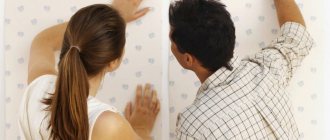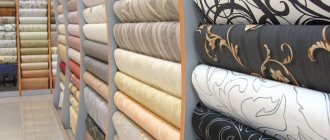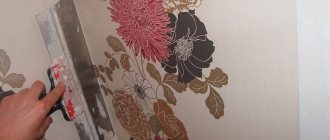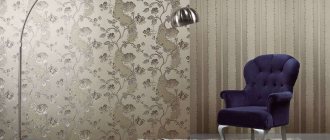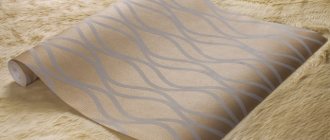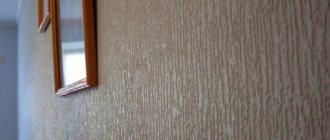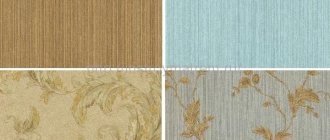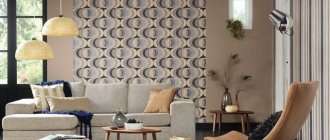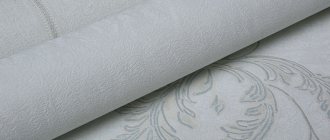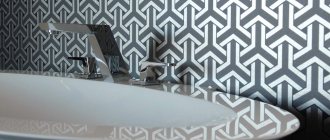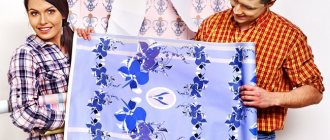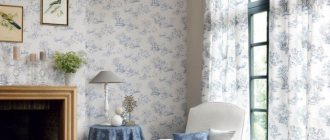When a person is faced with a large number of alternatives, each of which may differ only slightly from each other, making a choice is very difficult, since it is difficult to give preference to any option. Statistical and sociological studies show that in a stressful state, either nothing is done at all, or, as a rule, erroneous decisions are made. This fully applies to the purchase of wallpaper. A huge selection of trellises makes the purchasing process painful when you need to settle on a specific type of product here and now.
To make the purchasing process easier, we will compare the quality of vinyl and non-woven trellises and give recommendations for their use in different rooms of the apartment.
What is vinyl wallpaper
Vinyl wallpaper is a multilayer type of building material used for wall cladding, where the backing is paper or non-woven non-woven fabric, and the top layer is PVC (polyvinyl chloride). Essentially, PVC is a colorless, transparent thermoplastic polymer, i.e. plastic. People call it for short - vinyl, vestolite, hostalite, jeon, nippeon, sumilite, helvik, norvik, etc.
The structure of vinyl wallpaper.
Attention: from the above definition of vinyl wallpaper it clearly follows that the wallpaper backing cannot determine the type of trellis. However, on many web resources, vinyl trellises on a non-woven basis are called non-woven. This leads to improper use of the finishing material and its rapid deterioration; especially serious consequences occur when choosing the wrong type of wallpaper for the glue.
Recently, 3-layer trellises have become increasingly common on sale, where an opaque liner is attached between the base and the front film, hiding bright spots on the wall surface (the wallpaper does not show through).
A backing made of paper or non-woven fabric helps to firmly adhere the wallpaper with glue to the wall (plastic does not adhere well), and the plastic top protects from water, direct sunlight and scratches. Depending on the production method, there are:
- Trellis made of foamed vinyl - polyvinyl chloride applied to the substrate is subjected to heat treatment, as a result of which it foams, giving the wallpaper a three-dimensional structure with a beautiful relief;
- Hot stamping vinyl, when flat wallpaper is heated and a relief pattern is applied to the PVC film using special rollers.
This technology allows you to diversify the types of vinyl wallpaper. Highlight:
- Vinyl compact - imitates stone, natural leather, including crocodile, wood, brick. Such trellises are very durable and can withstand any mechanical stress;
- Evaporated vinyl - using a special technology, all harmful substances are removed from PVC, as a result of which it becomes environmentally friendly;
- Silk-screen wallpaper - silk threads are added to polyvinyl chloride, which shimmer in the light like real silk fabric;
- Kitchen vinyl - has a rubberized insert that turns trellises into an indispensable material for wall decoration in the kitchen and bathroom.
What are the properties of non-woven wallpaper?
To produce non-woven fabric, long cellulose fibers are taken. This gives them:
- Wallpaper made from this material does not get wet and is wear-resistant. Unlike paper materials, they are more difficult to spoil.
- When compressed or wrinkled, the interlining easily straightens out.
- Non-woven wallpaper does not attract dust and is difficult to get dirty. Washing is allowed if necessary.
- This type of wallpaper is very resistant to fire.
- Suitable for absolutely all categories of people.
- It is not afraid of dampness due to its moisture-repellent properties. Thanks to its qualities, it has a very long service life.
Thus, it is no coincidence that this type of finishing material has gained great popularity. In addition to excellent quality, positive aspects include the softness of the material and ease of working with it. If paper wallpaper requires a certain skill, since it is easy to damage, then even a novice master can handle non-woven wallpaper. When the time comes to change the wallpaper, it will peel off very easily from the wall surface without causing much trouble.
What is non-woven wallpaper
Non-woven (from the German word “Vliseline”, which means non-woven material) trellises are a rolled fabric made of cellulose fibers (about 70%) and additives. These are thin trellises with increased tensile strength. Despite their small thickness, they are embossed, creating a beautiful, original texture. They do not deform when the house shrinks. Easy to glue. They hide small imperfections on the wall surface well.
Non-woven fabric in its purest form.
According to numerous reviews on the forums, buyers are mostly satisfied with them. True, there are several sharply negative characteristics, but this is due to the fact that buyers were too lazy to find out in more detail what type of wallpaper they actually bought: non-woven or vinyl with a non-woven backing.
As a result, we bought glue for lightweight non-woven trellises, which fell off after a few days. This once again confirms the above statement that it is necessary to distinguish between non-woven wallpaper and vinyl wallpaper on a non-woven basis.
Features of ceiling pasting
Despite the fact that now you can repair the ceiling in different ways, many people prefer a quick and simple solution - wallpapering the ceiling. Preparatory work resembles the manipulations that are performed when preparing walls. The surface is cleaned of old finishing materials and leveled. A primer is applied to the ceiling.
You will need a marking cord to make the markings. The most important thing is to stick the first strip evenly. The rest should be tried to be joined to those already glued and smoothed out in a timely manner, removing air bubbles and excess glue.
Comparison of the characteristics of these types of wallpaper
The choice of wallpaper in practice occurs mainly according to two criteria: the cost of the material and its design. However, often, due to differences in operating conditions, it is necessary to determine which wallpaper is better - vinyl or non-woven, by comparing other characteristics:
- service life;
- resistance to abrasion and mechanical damage;
- ability to resist exposure to UV rays (burnout);
- difficulties of gluing;
- strength;
- how heavy;
- degree of impact on the health of family members;
- breathability.
Let's take a closer look at the difference between non-woven and vinyl wallpaper.
Which ones last longer
One of the most important criteria for choosing trellises is their service life. Which wallpaper to choose - vinyl or non-woven based on this indicator? Here, a lot depends on the operating conditions of the trellis: the presence of pets (cats, dogs) and small children. For vinyl, this is not a negative factor - they will last at least 10 years. Non-woven ones will have to be re-glued very soon - damage from animal claws and kids' pranks cannot be eliminated.
If there are no people in the apartment who can damage the top of the trellises, then the service life of non-woven trellises is approximately the same as vinyl ones - manufacturers indicate a service life of 10-12 years in both. At the same time, paintable wallpaper can last up to 3 decades and withstand 6 layers of dye.
Statistics show that on average, apartment owners change their wallpaper after 7-8 years of use - it begins to depress them psychologically. Therefore, the question of service life is not relevant.
Which ones don't burn out?
Just a couple of years ago, the issue of paint resistance to UV rays was relevant - non-woven wallpaper faded under the sun's rays. Today this problem has been solved - fade-resistant paint is applied to both types of trellises, preserving the richness of the color scheme under any operating conditions .
Which ones are heavier?
The main characteristics that influence the choice of wallpaper include the weight of the trellises - heavy wallpaper cannot be hung on the ceiling and they require special glue. In addition, heavy wallpaper is difficult to glue alone.
There has been some confusion regarding non-woven and vinyl wallpapers: some believe that non-woven wallpaper is heavier, while others, on the contrary, consider vinyl. It is quite difficult to explain the current situation. After all, non-woven fabric is essentially a lightweight non-woven fabric. Vinyl trellises, in principle, cannot be lighter - they have two, and when laying, three layers. At the same time, the backing is often the same non-woven material.
The answer, in our opinion, lies in the incorrect classification of trellises - some experts classify vinyl wallpaper on a non-woven backing as non-woven wallpaper.
Which ones are cheaper?
A very important difference between vinyl wallpaper and non-woven wallpaper is their price. When making budget repairs, there is no question of choice: non-woven trellises are generally 20-25% more expensive. Thus, a tube of medium-quality non-woven fabric 1 m wide costs more than 655 rubles, and high-quality, acrylic-coated, costs more than 1,200 rubles.
Vinyl wallpaper on paper can be found from 180 rubles. for the phone. The most expensive: embossed, multi-colored - no more than 600 rubles. Vinyl with a non-woven backing costs from 600 rubles. for the phone. Premium wallpapers of both types have approximately the same high price.
Which is easier to wash?
There are no apartments without dust. It’s just that in some there is less of it, in others there is more. Therefore, from time to time the question of caring for the walls arises: removing dust and cobwebs. In addition, sometimes force majeure circumstances arise: children’s drawings or splashes of fat, wine, etc. appear on the walls.
Vinyl wallpaper is easy to wash not only with a wet cloth, but also with detergents and rub with brushes. Therefore, any dirt, including grease stains and children's creativity, is washed off without affecting the wall - after drying, no traces remain.
It's a little more complicated with non-woven trellises. Contaminated areas cannot be removed. And dust and cobwebs can be removed with a vacuum cleaner or a damp cloth (not wet, but well twisted and not wiped, but brushed away). True, there are contradictions in the recommendations: many experts, due to the high hygroscopicity of non-woven fabric, categorically prohibit touching them with wet objects. Practice actively refutes this statement - most housewives remove dust with wet wipes or rags without damaging the wallpaper.
Which ones are thicker (stronger)
The rule does not apply to non-woven and vinyl trellises: thick means durable. There is another catch here: stronger tensile strength or the ability to withstand mechanical damage to the surface.
Vinyl wallpaper with a paper base is thicker than non-woven wallpaper, but it tears easier, while non-woven wallpaper is stronger.
If we are talking about mechanical damage to the surface (wear resistance), then the thickness of the wallpaper sheet and strength are in no way linked to each other - it all depends on the material of the top layer: non-woven fabric is easily damaged by pets and small children. Vinyl trellises can withstand repeated contact with furniture or clothing - they do not wear out.
Which is easier to glue?
When choosing trellises, the buyer pays little attention to the manufacturability of the wallpaper. And yet, vinyl or non-woven fabric - which is easier to glue? The answer is clear - non-woven wallpaper. Firstly, the adhesive mass is applied to the surface of the wall, therefore, the sheet of wallpaper does not get wet or stretch - it is easy to join with the previous sheet. Secondly, it follows from the first - you can glue alone. Thirdly, wider sheets mean fewer joints, and fewer joints mean easier fitting.
Vinyl trellises themselves are heavy, and the glue makes them even heavier, which greatly complicates the gluing process. Therefore, you have to glue them together.
Which is more environmentally friendly?
Non-woven fabric consists entirely of natural fibers and additives, while PVC is plastic. Therefore, you don’t even need to figure out what is unsafe for health - naturally, wallpaper is made of PVC , and therefore it is not recommended to glue it in children’s rooms and bedrooms.
In places where people spend a small amount of time, both types of wallpaper do not pose a threat to the health of family members. This is the living room, corridors, bathroom, kitchen.
Which ones have better design?
When evaluating wallpaper from the aesthetic side, it is necessary to note the huge advantage of vinyl wallpaper over non-woven wallpaper both in color and texture (relief patterns), especially since both types of wallpaper began to be produced for painting.
Which ones are breathable?
Non-woven fabric is a natural non-woven fabric. It is vapor- and air-permeable, so the walls “breathe” with it. Vinyl is impervious to air, steam and water. Therefore, due to temperature changes outside in the morning, condensation forms on the external walls, which leads to the appearance of mold under the PVC wallpaper. You can avoid trouble by treating the walls with special preparations against fungus and mold or using wallpaper glue with such additives.
Disadvantages of glass wallpaper
It would be completely wrong to talk only about the advantages of glass wallpaper. After all, this material has its own application features and disadvantages that limit the possibility of use in specific conditions. The disadvantages of glass wallpaper include:
- Lack of flexibility. The material does not withstand bending loads well. In particular, if you glue canvases to curved walls with large depressions and defects, the result may be the appearance of cracks and loss of presentability. In view of this, glass wallpaper should be used exclusively on leveled substrates with a small number of defects.
- Porosity. The presence of a porous structure is both an advantage and a disadvantage of glass wallpaper. On the one hand, this property allows the walls to “breathe”, but on the other hand, it increases paint consumption. The applied paint penetrates well into the porous structure, due to which the first painting requires the use of copious amounts of paint and varnish. This, in turn, results in additional budget expenditure.
- Heavy weight. Fiberglass wallpaper itself is heavy, which can negatively affect the quality of use. The mass of the material is also increased by a layer of paint and glue used to fix the paintings on the walls. Together they create a large load on the base. For this reason, glass wallpaper is not suitable for loose substrates, inclined surfaces and ceilings. For the same reason, it is not recommended to repaint glass wallpaper many times.
- Difficult to dismantle. After gluing and drying the glue, sometimes you have to tear off the glass wallpaper, as they say “alive” - along with the plaster.
- Loss of decorative effect when re-painted. Textured glass wallpaper has a slightly pronounced relief. Each subsequent painting will lead to a deterioration in the visual effect of the decor.
- High price. Fiberglass wallpaper itself is an expensive product. Along with the need for a large consumption of paint, carrying out repairs with such material can cost a pretty penny.
How to visually and tactfully distinguish one from the other
How to distinguish non-woven wallpaper from vinyl wallpaper in a shopping center if there is no price tag nearby? It's simple - you can determine the type of trellis both visually and by touch. There are several ways to check the appearance of the wallpaper with your eyes only:
- look at the end of the tube - vinyl trellises are multi-layered, 2-3 layers of loose, thick material, non-woven fabric has one thin layer;
- tear off a small corner of the tube; in non-woven wallpaper the tear area is fibrous, in vinyl it is slightly jagged, without lint;
- study the back side of the wallpaper - non-woven fabric is always smooth, even if there is embossing on the front side, while vinyl with any backing repeats the embossing pattern (due to the method of applying the relief).
How can you tell by touch which wallpaper is which? Non-woven fabrics are velvety, pleasant to the touch, vinyl on the front side is cold and smooth in feel, despite the presence of embossing.
Care instructions
One of the advantages of non-woven wallpaper is its ease of care. Therefore, below are some tips that will help maintain the reliability and durability of the wall covering:
- Textile and paper items cannot be washed. If dust or dirt collects on textured surfaces, you can clean it with a brush or vacuum cleaner;
- As for vinyl products, special detergents can be used for washing. This also applies to wallpaper that has been painted with waterproof paints;
- If you don’t know which cleaning method is suitable for non-woven covering, pay attention to the symbols:
- There is an image of one wave on the label, which means the wall covering is waterproof;
- If two waves are washable;
- If there are three waves, it is super washable.
What is better and in what case to choose
To give a definite answer as to which is better would be the height of arrogance and incompetence - each specific situation has its own solution. Let’s just try to give some recommendations for various rooms, which we will put in a table.
Table of wallpaper correspondence to rooms in an apartment (house).
| Room view | Wallpaper | |
| vinyl | non-woven | |
| corridor | fit perfectly | undesirable |
| kitchen | fit perfectly | categorically no |
| bathroom | can be glued | categorically no |
| bedroom | undesirable | fit perfectly |
| living room | fit perfectly | fit perfectly |
| children's room | categorically no | can be glued |
Paper
The most traditional type of wall covering familiar to everyone. Some believe that such wallpaper as a type is morally outdated, but we, for example, categorically disagree with this.
The main advantage of such wallpaper is the huge variety of prints and shades that can satisfy every taste.
Moreover, manufacturers are constantly working to improve the performance characteristics of the material for such wallpaper.
For decades, paper wallpapers have enjoyed universal recognition also due to their low cost, environmental friendliness, breathability and ease of gluing.
WITH
consist of one or two layers of paper. The top, decorative, is smooth, embossed or even corrugated.
The pattern on smooth wallpaper is printed on a printer and fades quite quickly in direct sunlight. The luxury variety is distinguished by hand-printed designs and a primer that prevents them from fading.
However, when choosing such wallpaper, you need to remember the following factors:
- Fragility. The average service life is five years, after its expiration they lose their attractive appearance;
- Low strength. Stains, dirt, and scratches are easily left, and restoration can only be done by replacing damaged pieces.
- Hygroscopicity. They absorb moisture and odors, so they are not suitable for rooms with high humidity.
